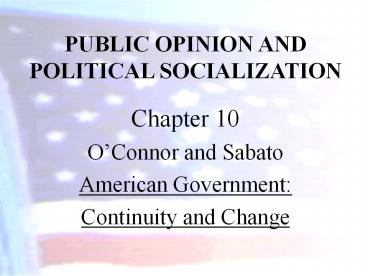PUBLIC OPINION AND POLITICAL SOCIALIZATION - PowerPoint PPT Presentation
Title:
PUBLIC OPINION AND POLITICAL SOCIALIZATION
Description:
PUBLIC OPINION AND POLITICAL SOCIALIZATION Chapter 10 O Connor and Sabato American Government: Continuity and Change PUBLIC OPINION AND POLITICAL SOCIALIZATION In ... – PowerPoint PPT presentation
Number of Views:184
Avg rating:3.0/5.0
Title: PUBLIC OPINION AND POLITICAL SOCIALIZATION
1
PUBLIC OPINION AND POLITICAL SOCIALIZATION
- Chapter 10
- OConnor and Sabato
- American Government
- Continuity and Change
2
PUBLIC OPINION AND POLITICAL SOCIALIZATION
- In this chapter we will cover
- What is Public Opinion?
- Early Efforts to Influence and Measure Public
Opinion - Political Socialization and Other Factors That
Influence Opinion Formation - How We Form Political Opinions
- How We Measure Public Opinion
3
What is Public Opinion?
- Public opinion is 'what the people think about an
issue or set of issues at any given point in
time' and opinions are normally measured by
opinion polls.
4
Opinion Polls
- Polls are interviews or surveys of a sample of
citizens used to estimate how the public feels
about an issue or set of issues.
5
Early Efforts to Influence and Measure Public
Opinion
- Public opinion polling as we know it today
developed in the 1930s. - As early as 1824, newspapers have tried to
predict election winners using polls. - Literary Digest used straw polls that are now
seen as highly problematic. - The American Voter was published in 1960 and
continues to influence the way we think of mass
attitudes and behavior. - This book studied the 1952 and 1956 presidential
elections and discussed how class coalitions led
to party affiliation.
6
(No Transcript)
7
Political Socialization and Other Factors That
Influence Opinion Formation
- Political attitudes are grounded in values. We
learn our values by a process known as political
socialization. - Many factors influence opinion formation.
- The Family
- The Mass Media
- School and Peers
- The Impact of Events
- Social Groups
- Religion
- Race
- Gender
- Region
8
(No Transcript)
9
(No Transcript)
10
(No Transcript)
11
(No Transcript)
12
How We Form Political Opinions
Political Opinions
Personal Beliefs
Political Knowledge
Cues From Leaders
13
How We Measure Public Opinion
- In order for a poll to be reliable, it must have
- Proper question wording
- An accurate sample
- contacting respondents Since 95 of Americans
have phones, random phone calling would be a
valid method.
14
How We Measure Public Opinion
- In general, do not trust a poll that does not
tell you the question wording, the sampling
method, and the ways in which respondents were
contacted. - Reputable pollsters will also tell you the number
of respondents (the 'n') and the error rate ( or
- 5). - Any poll that tells you to call 555-5554 for yes
and 555-5555 for no is unscientific and
unreliable. This is not a random sample at all!
15
(No Transcript)
16
(No Transcript)
17
(No Transcript)
18
Types of Polls
- Tracking polls--continuous surveys that enable a
campaign to chart its daily rise and fall in
popularity. These may be a decent measure of
trends. - Exit polls--polls conducted at polling places on
election day. - Deliberative polls--a new kind of poll first
tried in 1996. A relatively large scientific
sample of Americans (600) were selected for
intensive briefings, discussions, and
presentations about issue clusters including
foreign affairs, the family, and the economy. - A deliberative poll attempts to measure what the
public would think if they had better
opportunities to thoughtfully consider the issues
first.































